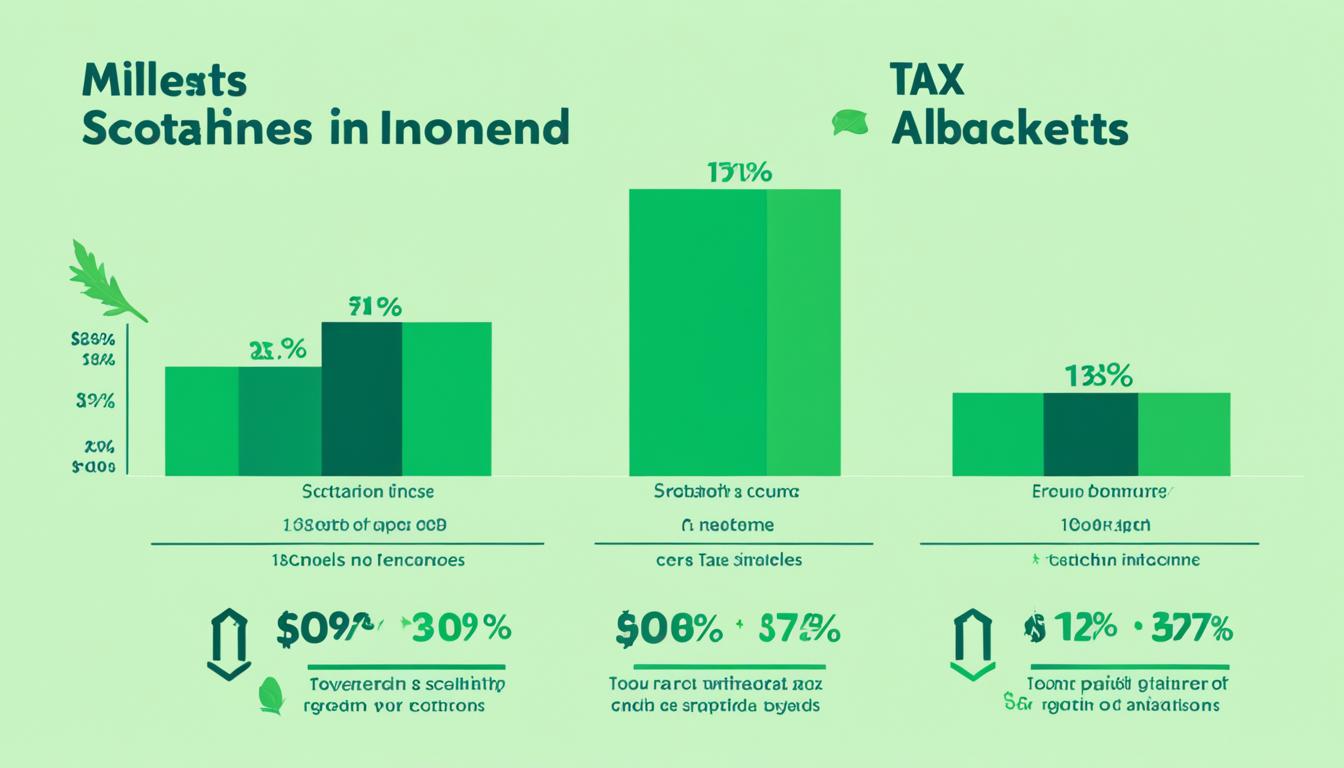Last Updated on: 11th May 2024, 10:38 am
Did you know that the average Scottish taxpayer pays a whopping £1,500 more in income tax annually compared to their counterparts in the rest of the UK? This surprising statistic highlights the importance of understanding the Scottish Income Tax system and its impact on your personal finances.
This comprehensive guide provides a clear understanding of the tax obligations for individuals living in Scotland. It covers the current rates of Scottish Income Tax, including the tax bands and rates for the 2024/2025 tax year, as well as the personal allowance and tax-free income. The guide also explains who is considered a Scottish taxpayer and the residency requirements, with examples of Scottish Income Tax calculations and a comparison to UK Income Tax.
Additionally, the article addresses the tax implications of moving to or from Scotland, living in multiple homes, and changes for the 2023/2024 tax year. It also covers Scottish Income Tax on other income sources, such as dividends, savings, pensions, and rental income, as well as the administrative aspects like HMRC’s role and PAYE/Self-Assessment for Scottish taxpayers. Finally, the guide provides information on marriage allowance and gift aid donations for Scottish taxpayers.
Introduction to Scottish Income Tax
Scottish Income Tax is a devolved tax collected by HM Revenue and Customs (HMRC) on behalf of the Scottish Government. It applies to non-savings and non-dividend income of Scottish taxpayers, such as employment income, self-employment profits, rental income, and pensions. The key differences between Scottish Income Tax and UK Income Tax are the tax bands, rates, and thresholds.
Differences from UK Income Tax
The Scottish tax system has a distinct structure compared to the UK Income Tax system. While the personal allowance and tax-free income thresholds are the same, the tax bands and rates can vary significantly. This means that Scottish taxpayers may pay a different amount of income tax compared to their counterparts in England, Wales, or Northern Ireland, depending on their level of income.
Importance of Understanding Scottish Income Tax
Understanding the differences in the Scottish tax system is crucial for individuals living in or moving to Scotland. Knowing how Scottish Income Tax is calculated and how it compares to the UK Income Tax system can help taxpayers ensure they are paying the correct amount of tax and taking advantage of any applicable allowances and reliefs. This awareness can be particularly important for those with higher incomes or complex tax situations, as the divergence in tax rates and bands can have a significant impact on their overall tax liability.
Current Rates of Scottish Income Tax
The current rates of Scottish Income Tax for the 2024/2025 tax year are detailed below. Understanding these scottish income tax bands 2024/2025 and scottish income tax rates 2024/2025 is crucial for Scottish taxpayers to accurately determine their tax liabilities.
Tax Bands and Rates for 2024/2025
Taxable income in Scotland is subject to the following tax bands and rates for the 2024/2025 tax year:
| Taxable Income | Tax Rate |
|---|---|
| Up to £12,570 | 0% (Personal Allowance) |
| £12,571 to £14,876 | 19% (Starter rate) |
| £14,877 to £26,561 | 20% (Basic rate) |
| £26,562 to £43,662 | 21% (Intermediate rate) |
| £43,663 to £75,000 | 42% (Higher rate) |
| £75,001 to £125,140 | 45% (Advanced rate) |
| Over £125,140 | 48% (Top rate) |
Personal Allowance and Tax-Free Income
The personal allowance and tax-free income in scotland is set at £12,570 for the 2024/2025 tax year. This means that the first £12,570 of your taxable income is not subject to any Scottish Income Tax. However, this allowance is reduced by £1 for every £2 of income above £100,000.
By understanding the current scottish income tax bands 2024/2025 and scottish income tax rates 2024/2025, as well as the personal allowance and tax-free income in scotland, Scottish taxpayers can ensure they are paying the correct amount of income tax and taking advantage of any applicable allowances or reliefs.
Who Pays Scottish Income Tax?
To be considered a Scottish taxpayer, you must be resident in Scotland for tax purposes. This means that your main home is located in Scotland, or you spend the majority of your time in Scotland compared to any other part of the United Kingdom.
Definition of a Scottish Taxpayer
The residency requirements for Scottish taxpayer status are based on where you live, not your nationality or place of birth. HM Revenue and Customs (HMRC) utilises various factors, such as your address, workplace, and the time you spend in different regions of the UK, to determine your taxpayer status.
Residency Requirements
It is crucial to ensure that HMRC has the correct information about your residency to guarantee you pay the appropriate amount of Scottish Income Tax. If you have multiple homes or frequently move between Scotland and other parts of the UK, it is important to document your residency accurately to avoid any issues with your tax obligations.

How Much Tax Will I Pay in Scotland?
The amount of tax you pay in Scotland will depend on your level of income and the applicable tax bands and rates. For individuals with lower incomes (under £28,867), they will generally pay less income tax in Scotland compared to the rest of the UK. However, for those with higher incomes (over £43,662), they may pay more income tax in Scotland due to the higher tax rates.
Examples of Scottish Income Tax Calculations
The guide provides examples of Scottish Income Tax calculations, showing the tax payable for both lower and higher-income taxpayers. For a Scottish taxpayer with an annual income of £25,000, the tax liability would be £2,451. In comparison, a UK taxpayer with the same income would pay £3,100 in income tax, a difference of £649. Conversely, a Scottish taxpayer with an annual income of £60,000 would pay £12,263 in tax, while a UK taxpayer with the same income would pay £11,700, a difference of £563.
Comparing Scottish and UK Income Tax
The six-band structure of Scottish Income Tax can have a significant impact on the overall tax liability for Scottish residents. This highlights how scottish income tax compares to uk income tax and the tax differences for scottish vs uk taxpayers. By understanding the nuances of the Scottish Income Tax system, individuals can ensure they are paying the correct amount of tax and taking advantage of any applicable allowances and reliefs.
Moving to or from Scotland
If you move to or from Scotland, it can have significant tax implications. Your taxpayer status, and therefore the amount of income tax you pay, will depend on your residency.
If you move to Scotland, you will become a Scottish taxpayer and your income tax will be calculated based on the Scottish Income Tax rates and bands. Conversely, if you move from Scotland to another part of the UK, you will become a UK taxpayer, and your income tax will be calculated using the UK Income Tax system.
Tax Implications of Changing Residency
The guide explains the tax implications of changing residency and how to ensure HMRC has the correct information to determine your taxpayer status. It is crucial to understand how changing residency affects Scottish income tax to ensure you pay the appropriate amount of tax.

Living in Multiple Homes
If you have multiple homes, determining your taxpayer status and calculating the appropriate income tax can be more complex. The guide explains the factors HM Revenue and Customs (HMRC) considers when determining your taxpayer status, such as the time spent in each residence and the location of your main home.
Determining Taxpayer Status
HMRC utilises various factors to ascertain your taxpayer status when you have homes in different regions. This includes evaluating the amount of time you spend in each residence, the location of your principal home, and your overall presence and connections within Scotland. Accurately documenting your residency is crucial to ensure you pay the correct amount of Scottish Income Tax.
Tax Calculations for Multiple Residencies
The guide provides examples of how the tax calculations would work for individuals with homes in both Scotland and other parts of the United Kingdom. This highlights the importance of precisely tracking your residency to guarantee you fulfil your Scottish Income Tax obligations appropriately, whether you have multiple homes
| Scenario | Taxpayer Status | Tax Calculation |
|---|---|---|
| Individual with a primary residence in Scotland and a second home in England | Scottish Taxpayer | Income tax calculated based on Scottish Income Tax rates and bands |
| Individual with a primary residence in England and a second home in Scotland | UK Taxpayer | Income tax calculated based on UK Income Tax rates and bands |
| Individual who divides their time equally between homes in Scotland and England | Scottish Taxpayer | Income tax calculated based on Scottish Income Tax rates and bands, with potential adjustments for time spent in each region |
Changes for the 2023/2024 Tax Year
For the 2023/2024 tax year, there have been several changes to the scottish income tax changes 2023/2024. The new scottish income tax rates and bands for 2023/2024 have been updated, with the introduction of a new “Top rate” of 48% for income over £125,140. Additionally, the Personal Allowance has remained at £12,570, and the thresholds for the other tax bands have been adjusted to reflect the changes.
New Tax Rates and Bands
The guide provides details on the new tax rates and bands for the 2023/2024 tax year, ensuring readers are aware of the latest updates to the scottish income tax system. This information is crucial for scottish taxpayers to understand their tax obligations and plan their finances accordingly.

Scottish Income Tax and Other Income Sources
Whilst Scottish Income Tax applies to non-savings and non-dividend income, such as employment, self-employment, and pension income, Scottish taxpayers will still pay the same tax as the rest of the UK on dividends and savings interest. This section of the guide explores how these other income sources, including dividends, savings, pensions, and rental income, are taxed and how they interact with the Scottish Income Tax system.
Dividends and Savings Income
Scottish taxpayers will pay the same tax rates on their dividend and savings income as individuals in the rest of the UK. The tax on dividends is charged at 7.5% (basic rate), 32.5% (higher rate), and 38.1% (additional rate), while the tax on savings interest is charged at the respective personal savings allowance rates. This means that Scottish taxpayers’ liability on these income sources is not affected by the Scottish Income Tax system, which is focused on non-savings and non-dividend income.
Pensions and Rental Income
Scottish Income Tax does, however, apply to pension income and rental income. Pension payments, whether from state pensions, private pensions, or workplace pensions, are subject to the Scottish Income Tax bands and rates. Similarly, income from rental properties is also taxed according to the Scottish Income Tax system. This ensures that Scottish taxpayers’ overall tax liability, including these other income sources, is calculated based on the unique Scottish Income Tax structure.
By understanding how these additional income sources are taxed, Scottish taxpayers can gain a comprehensive understanding of their total tax obligations and ensure they are paying the correct amount of tax based on their individual circumstances and income levels.
Tax Collection and Administration
HM Revenue and Customs (HMRC) plays a crucial role in the collection and administration of Scottish Income Tax. Scottish taxpayers pay their income tax according to the Scottish Income Tax rates and bands through the Pay As You Earn (PAYE) system or self-assessment.
HMRC’s Role in Collecting Scottish Income Tax
As the UK’s tax authority, HMRC is responsible for the collection and administration of all income tax, including Scottish Income Tax. HMRC works closely with the Scottish Government to ensure that Scottish taxpayers pay the correct amount of tax based on the devolved tax system. This involves identifying Scottish taxpayers, calculating their tax liabilities, and managing the payment and reporting processes.
PAYE and Self-Assessment for Scottish Taxpayers
Scottish taxpayers can easily identify their status on payslips, P60 forms, and tax summaries provided by HMRC. For those employed under the PAYE system, their income tax is calculated and deducted from their wages by their employer, based on the Scottish Income Tax rates and bands. Alternatively, Scottish taxpayers who are self employed or have other sources of income must declare and pay their taxes through the self-assessment process, again following the Scottish Income Tax system.
By understanding HMRC’s role and the PAYE and self assessment procedures, Scottish taxpayers can ensure they are fulfilling their tax obligations and paying the appropriate amount of income tax.

Marriage Allowance and Gift Aid Donations
The marriage allowance, which allows eligible taxpayers to transfer 10% of their personal allowance to their spouse or civil partner, is still applicable for Scottish taxpayers. However, the eligibility criteria are slightly different, as Scottish taxpayers who pay tax at the starter, basic, or intermediate rates (and the basic rate of UK tax on savings income) are eligible, while those paying the higher, advanced, or top rates are not.
Eligibility for Marriage Allowance
To be eligible for the marriage allowance, Scottish taxpayers must meet the following criteria:
- Pay tax at the starter, basic, or intermediate rates (or the basic rate of UK tax on savings income)
- Have a spouse or civil partner who earns less than the personal allowance (£12,570 for the 2024/2025 tax year)
- Not be claiming the marriage allowance themselves
Gift Aid Tax Relief for Scottish Taxpayers
In addition to the marriage allowance, gift aid donations continue to benefit from tax relief for Scottish taxpayers. The charity can claim tax relief at the UK basic rate of 20%, regardless of the donor’s Scottish Income Tax rate. This means that for every £1 donated, the charity can claim an additional 20 pence, even if the donor is paying the higher, advanced, or top rates of Scottish Income Tax.
Frequently Asked Questions
In this section, we’ll address some of the most commonly asked questions about scottish income tax, helping you navigate the complexities of the Scottish tax system with greater clarity.
What is the difference between Scottish Income Tax and UK Income Tax?
The primary difference between Scottish Income Tax and UK Income Tax lies in the tax bands and rates. While UK Income Tax has three main bands (basic, higher, and additional rate), Scottish Income Tax has six bands, ranging from the starter rate to the top rate. This results in Scottish taxpayers potentially paying a different amount of income tax compared to their counterparts in other parts of the UK, depending on their level of income.
How do I know if I’m a Scottish taxpayer?
Your taxpayer status is determined by your residency, not your nationality or where you were born. If your main home is in Scotland, or you spend the most time in Scotland compared to any other part of the UK, you will be considered a Scottish taxpayer. HMRC uses various factors, such as your address, workplace, and time spent in different regions, to determine your taxpayer status.
Can I claim the marriage allowance if I’m a Scottish taxpayer?
Yes, the marriage allowance is still applicable for Scottish taxpayers, but the eligibility criteria are slightly different. Scottish taxpayers who pay tax at the starter, basic, or intermediate rates (and the basic rate of UK tax on savings income) are eligible to claim the marriage allowance, while those paying the higher, advanced, or top rates are not.
How do I calculate my scottish income tax liability?
To calculate your Scottish Income Tax liability, you’ll need to determine your taxable income and apply the relevant tax bands and rates. The guide provides several examples of Scottish Income Tax calculations, showing how the different tax bands and rates impact the overall tax payable for both lower and higher-income taxpayers.
| Taxable Income | Tax Rate |
|---|---|
| Up to £12,570 | 0% (Personal Allowance) |
| £12,571 to £14,876 | 19% (Starter rate) |
| £14,877 to £26,561 | 20% (Basic rate) |
| £26,562 to £43,662 | 21% (Intermediate rate) |
| £43,663 to £75,000 | 42% (Higher rate) |
| £75,001 to £125,140 | 45% (Advanced rate) |
| Over £125,140 | 48% (Top rate) |
Remember, the Personal Allowance, which is the amount of income you do not pay tax on, is set at £12,570 for the 2024/2025 tax year. This allowance is reduced by £1 for every £2 of income above £100,000.
Conclusion
This comprehensive guide has provided a clear and detailed overview of the Scottish Income Tax system, covering the current summary of key points on scottish income tax. By understanding the nuances of the Scottish Income Tax system, individuals can ensure they are paying the correct amount of tax and taking advantage of any applicable allowances and reliefs.
The guide has highlighted the key differences between Scottish and UK Income Tax, emphasising the importance of understanding scottish tax system. It is crucial for individuals to be aware of their taxpayer status and the potential impact on their overall tax liability.
Readers are encouraged to refer to the relevant government websites and resources for any further information or updates on the Scottish Income Tax system. Staying informed and up-to-date on the where to find more information on scottish income tax is essential to ensure compliance and maximise tax efficiency.
FAQ
1. Who is considered a Scottish taxpayer?
You are considered a Scottish taxpayer if your main home is in Scotland, or you spend the most time in Scotland compared to any other part of the UK. The residency requirements for Scottish taxpayer status are based on where you live, not your nationality or where you were born.
2. How does Scottish Income Tax compare to UK Income Tax?
For individuals with lower incomes (under £28,867), they will generally pay less income tax in Scotland compared to the rest of the UK. However, for those with higher incomes (over £43,662), they may pay more income tax in Scotland due to the higher tax rates.
3. What are the tax implications of moving to or from Scotland?
If you move to Scotland, you will become a Scottish taxpayer and your income tax will be calculated based on the Scottish Income Tax rates and bands. Conversely, if you move from Scotland to another part of the UK, you will become a UK taxpayer, and your income tax will be calculated using the UK Income Tax system.
4. How is Scottish Income Tax collected and administered?
HM Revenue and Customs (HMRC) is responsible for the collection and administration of all income tax in the UK, including Scottish Income Tax. Scottish taxpayers pay income tax calculated according to Scottish Income Tax rates and bands through the Pay As You Earn (PAYE) system or self-assessment.
5. How does the marriage allowance and gift aid donations work for Scottish taxpayers?
The marriage allowance, which allows eligible taxpayers to transfer 10% of their personal allowance to their spouse or civil partner, is still applicable for Scottish taxpayers. Additionally, gift aid donations continue to benefit from tax relief for Scottish taxpayers, with the charity claiming tax relief at the UK basic rate of 20%, regardless of the donor’s Scottish Income Tax rate.




















No Comments
Leave a comment Cancel